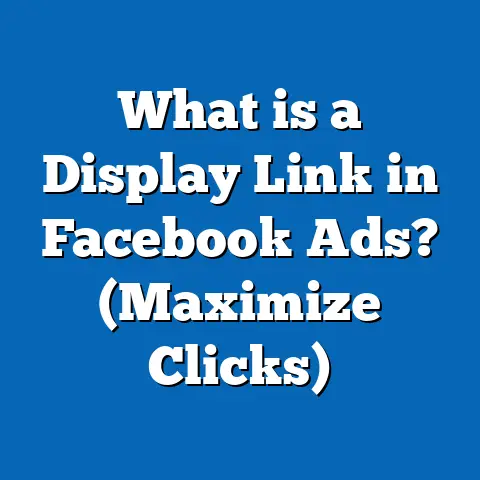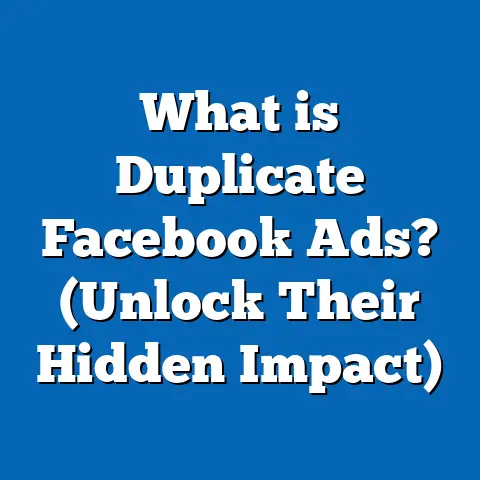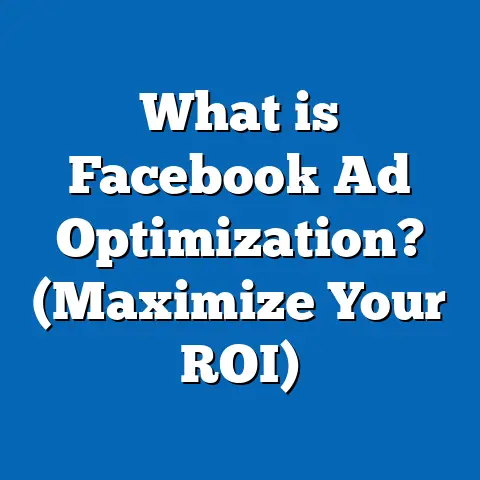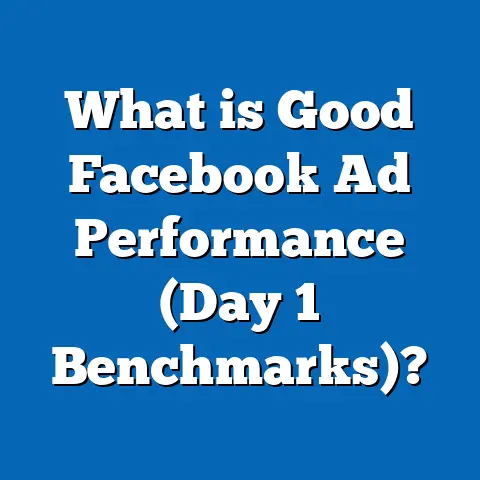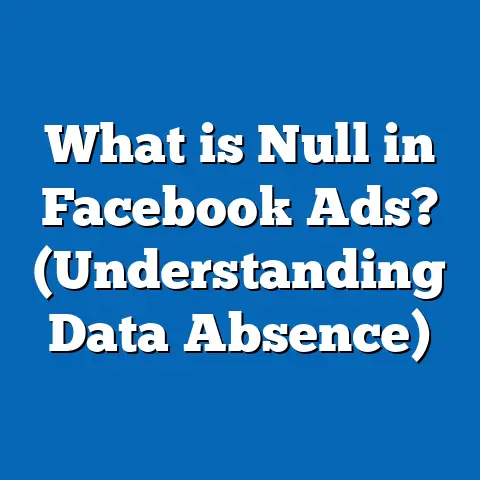What is Unused Budget in Facebook Ads? (Unlock Hidden Savings)
Introduction: Unused Budget and Eco-Friendly Mindset in Facebook Ads
In today’s marketing world, efficiency goes beyond merely reducing costs. It’s about making sure every resource is used wisely—much like how eco-friendly choices help reduce waste and preserve resources in our daily lives. When you think about advertising budgets, the idea of “unused budget” might seem like missed opportunities or even wasted money. However, understanding what unused budget means in Facebook Ads can actually reveal hidden savings and create room for smarter spending.
Imagine your advertising budget as a limited natural resource. If you use it wisely, you reduce waste and get maximum value. If you don’t, it’s like throwing money away, just like wasting energy or plastic harms the environment. In this guide, we’ll uncover what unused budget in Facebook Ads means, why it happens, and how to identify and fix it to maximize your campaign’s return on investment (ROI). We’ll also share real-world data, case studies, and up-to-date strategies to help you unlock these hidden savings.
What is Unused Budget in Facebook Ads?
Defining Unused Budget
Unused budget is the amount of money you allocate to your Facebook ad campaigns that Facebook does not spend within your specified timeframe. This can happen with both daily budgets and lifetime budgets. For example, if you set a daily budget of $100 but only $85 is spent by the end of the day, the remaining $15 is considered unused budget.
It’s important to note that unused budget does not mean overspending—Facebook never spends more than your set budget. Instead, it means that Facebook was unable to fully deliver your ads due to various reasons, resulting in some of your budget staying idle.
Types of Budgets in Facebook Ads
- Daily Budget: The average amount you want to spend each day.
- Lifetime Budget: The total amount you want to spend over the lifetime of the campaign.
Unused budget can occur in both types. With lifetime budgets, Facebook may pace spending unevenly but will try to use the entire budget by the campaign end date. Daily budgets give Facebook more flexibility but may lead to unused funds if delivery opportunities are limited on certain days.
Why Does Unused Budget Happen?
Understanding why unused budget occurs is crucial for fixing it. Here are the main reasons:
1. Limited Audience Size or Reach
If your audience is very small or very specific, Facebook may struggle to find enough people to show your ads to at your bid or cost goals. For example, targeting a very narrow geographical area combined with detailed interests might limit available impressions.
Data Insight:
According to Facebook’s own advertising guidelines, audiences smaller than 1,000 people can severely limit delivery potential.
2. Bid Strategy Constraints
Setting manual bids too low or tight cost caps can restrict Facebook’s ability to win auctions for ad placements. When bids are below market rates, fewer impressions are won, leaving part of your budget unspent.
3. Campaign Objective & Optimization
Certain objectives, such as conversion campaigns, require users to perform specific actions (like completing a purchase). If your audience doesn’t engage enough or the conversion event is rare, Facebook may not spend all your budget trying to achieve these results.
4. Ad Quality & Relevance
Facebook ranks ads based on relevance scores (now replaced with quality ranking metrics). Ads with low engagement or poor feedback get lower delivery priority. This reduces opportunities for spend.
5. Budget Settings vs Audience Size
If your budget is disproportionately large compared to your audience size or bid limits, Facebook may pace spend conservatively to avoid overspending when demand is low.
The Importance of Understanding Unused Budget
Unused budget is often overlooked but has a real impact on marketing efficiency and results.
Financial Efficiency and ROI
Every dollar not spent is a missed chance to generate clicks, leads, or sales. While unused budget isn’t lost money directly (you’re not charged for what isn’t spent), it represents an opportunity cost—money that could have been invested elsewhere.
Campaign Optimization Signals
A high unused budget signals that your campaign setup needs adjustment—whether it’s targeting, bidding, or creative quality. It’s a key indicator for marketers to improve campaign health.
Strategic Budget Allocation
Understanding unused budget helps marketers shift funds toward higher-performing campaigns or platforms rather than leaving money idle.
Data-Backed Insights on Facebook Ad Spending and Unused Budget
Facebook Ad Spend Growth
Facebook remains one of the largest digital ad platforms globally. In 2023, Facebook ad revenue hit approximately $140 billion worldwide (Statista). Advertisers spent an average of $1,000 to $5,000 per month on campaigns depending on industry size and campaign goals.
Industry Benchmarks for Unused Budget
Data from AdEspresso’s analysis indicates that:
- On average, advertisers experience 5-15% unused budget per campaign.
- Campaigns with very narrow targeting or strict bid caps can see unused budgets rise as high as 25%.
- Campaigns using automatic bidding and broader audiences tend to have less than 5% unused budget.
Impact on Campaign Performance
A WordStream study showed that advertisers who optimized their campaigns to reduce unused budget improved their ROAS by 15-20%. This improvement stemmed from better audience targeting and bid adjustments.
How Does Facebook Manage Your Budget?
Delivery System Overview
Facebook’s ad delivery system uses an auction model where advertisers bid for impressions based on their goals and bid strategy.
Key Points:
- Facebook tries to spend your budget evenly over time.
- It prioritizes ads based on predicted performance (estimated action rates).
- Ads compete in auctions where bid amount, ad quality, and user engagement predict likelihood of winning placements.
- If demand is low or bids are uncompetitive, spend slows down or stops before using full budget.
Spending Limits and Pacing Algorithms
Facebook uses pacing algorithms that spread out your ad spend over the day or campaign duration rather than spending all at once. This pacing prevents exhausting budgets early but can sometimes lead to underspending if conditions change during the day.
In-depth Examples of Unused Budget Scenarios
Scenario 1: Local Retailer with Narrow Targeting
A small bookstore sets a daily budget of $40 targeting a 5-mile radius around their location with interests related to books and reading. Using manual bidding capped at $0.30 per click, they find only $25 spent daily because:
- The audience size (~5,000) is limited.
- Bid cap is too low compared to competition.
- Conversion events (store visits) are tracked but rare.
Result: $15 remains unused daily.
Scenario 2: E-Commerce Brand Using High Cost Cap
An online fashion retailer runs a conversion campaign with a cost cap set at $15 per purchase but average conversion costs hover around $10. Facebook restricts spending because it tries not to exceed the cap but struggles with scaling conversions at this price point.
Result: Only 70% of the allocated budget is spent daily.
Scenario 3: New Product Launch with Low Ad Quality
A tech startup launches a new gadget with poor ad creatives (low engagement images and unclear messaging). Despite having a reasonable audience size and budget ($200/day), Facebook deprioritizes delivery due to low estimated relevance scores.
Result: Only $120 spent daily; $80 unused.
Strategies to Unlock Hidden Savings from Unused Budget
Reducing unused budget is easier with a clear plan:
1. Broaden Your Audience Targeting
Expanding your audience increases opportunities for impressions and spending your full budget.
- Use lookalike audiences based on existing customers.
- Add interest-based targeting alongside demographics.
- Avoid restrictive layering of multiple narrow segments.
Example: A travel company increased their audience size by 3x using lookalikes and reduced unused budget from 20% to 8%.
2. Adjust Bid Strategy
Switch from manual bidding or cost caps to automatic bidding when possible. Automatic bids allow Facebook’s algorithm flexibility in auctions.
- Increase manual bids gradually if automatic bidding isn’t an option.
- Monitor bid competitiveness using Facebook’s Auction Insights tool.
Tip: Avoid setting bid caps too low; research average CPCs in your niche first.
3. Optimize Ad Quality & Relevance
Higher relevance scores lead to better delivery priority.
- Test multiple creatives and formats (videos often outperform images).
- Use clear messaging tailored for your audience.
- Refresh creatives regularly to avoid ad fatigue.
Case Study: A food delivery service refreshed their ads monthly and saw relevance scores increase from 4/10 to 8/10 with corresponding drop in unused budgets.
4. Use Campaign Budget Optimization (CBO)
CBO lets Facebook automatically allocate your total campaign budget across ad sets based on real-time performance data.
- Reduces overspending on underperforming ad sets.
- Maximizes spend on best-performing segments.
- Helps prevent funds being stuck in low-delivery ad sets.
5. Use Dayparting (Ad Scheduling)
If your target audience is more active at specific times of day, schedule ads only during those periods to concentrate spend efficiently.
Additional Tips for Managing Unused Budgets
Monitor Delivery Insights Regularly
Use Facebook Ads Manager’s delivery reports to spot any irregularities such as consistent underspending or under-delivery alerts.
Leverage Automated Rules for Alerts
Set up automated rules in Ads Manager to notify you when spending drops below a certain threshold compared to budgets.
Consider Lifetime Budgets for Flexibility
Lifetime budgets give Facebook more leeway in pacing spend across days versus strict daily caps that might cause underspending on low-demand days.
Case Study: E-Commerce Brand Reduces Unused Budget by 40%
Background: An online apparel brand running multiple prospecting campaigns experienced an average of 12% unused budget due to narrow audiences and manual bidding caps.
Actions Taken:
| Metric | Before Optimization | After Optimization | Improvement |
|---|---|---|---|
| Average Unused Budget (%) | 12% | 7% | -40% |
| Monthly ROAS | 3.8x | 4.5x | +18% |
| Cost Per Acquisition (CPA) | $22 | $18 | -18% |
The brand unlocked hidden savings by addressing both targeting and bid strategy issues while improving ad quality.
Comparing Facebook Ads Unused Budget with Other Platforms
| Feature | Facebook Ads | Google Ads | LinkedIn Ads |
|---|---|---|---|
| Audience Targeting | Detailed demographics & interests | Keyword search + intent | Professional + job titles |
| Bid Strategy | Manual & automatic bidding | Manual CPC/CPA & Smart Bidding | Manual CPC & automated options |
| Budget Pacing | Pacing algorithm over day/campaign | Daily spend limits | Daily & total budget pacing |
| Typical Unused Budget | 5-15% average | Lower (<5%) due to keyword intent | Moderate (~10%) due to niche audiences |
| Optimization Tools | CBO & automated rules | Smart Bidding & Recommendations | Automated bidding & retargeting |
Google Ads tends to have less unused budget because keyword intent drives immediate demand. LinkedIn’s niche professional targeting can result in moderate unused budgets similar to Facebook if audiences are too narrow or bids are low.
Explaining Technical Concepts Simply
What Is Bid Cap?
A bid cap is the maximum amount you are willing to pay per desired action (such as a click or conversion). If you set this too low compared to other bidders competing for the same audience, fewer auctions are won, resulting in lower spend and hence unused budget.
What Is Cost Cap?
Cost cap lets you set a target average cost per result while giving Facebook some flexibility in individual auction bids. This helps control costs but if set too tightly can restrict spend.
What Is Campaign Budget Optimization (CBO)?
CBO allows you to set one overall campaign budget instead of individual ad set budgets. Facebook automatically distributes this money across ad sets dynamically based on which are performing best in real time—reducing waste where some ad sets might otherwise underspend.
What Is Relevance Score / Quality Ranking?
Relevance score was a metric that measured how well your ad matched the audience’s interests and behavior; now replaced by quality ranking metrics such as quality ranking, engagement rate ranking, and conversion rate ranking which influence how often your ads get shown and at what cost.
Latest Industry Trends Affecting Budget Usage on Facebook
AI-Powered Optimization
Facebook continuously improves its AI algorithms that predict which users are most likely to convert. This smart delivery reduces wasted spend but requires proper setup from advertisers.
Privacy Changes Impacting Data Access
With iOS privacy changes limiting Facebook’s data tracking capabilities (via ATT), advertisers now have less granular data for precise targeting which can increase unused budgets unless strategies adapt accordingly.
Rising Competition & Costs
More advertisers lead to increased competition driving up CPCs and CPMs—low bids risk leaving budgets unspent as they lose auctions more frequently.
Rise of Video & Interactive Formats
Video ads often generate higher engagement rates leading to better relevance scores and more efficient spending—reducing unused budgets.
Step-by-Step Guide: How To Audit Your Campaign for Unused Budget
- Log into Facebook Ads Manager
- Go to Campaigns Tab
- Add Columns: Customize columns by adding “Amount Spent,” “Budget,” “Delivery” status.
- Calculate Unused Budget: Compare budget vs amount spent manually or export data.
- Check Delivery Status: Look for any warnings such as “Limited by Audience” or “Bid Too Low.”
- Analyze Audience Size: Use Audience Insights tool.
- Review Bid Strategy: Note whether manual or automatic bidding is used.
- Check Relevance Scores/Quality Rankings: Look for signs of low-quality ads.
- Look for Overnight Spending Drops: Use breakdowns by time of day.
- Set Automated Rules: Notify you when spending falls below thresholds.
- Prepare Optimization Plan: Based on findings above.
Practical Tools & Resources for Managing Budgets
- Facebook Ads Manager Reports: Built-in detailed metrics
- Facebook Auction Insights: Understand competitive landscape
- AdEspresso’s Free Tools: Analyze campaigns for optimization opportunities
- Google Analytics: Correlate traffic data with ad spend efficiency
- Third-party Platforms: Like Hootsuite Ads or Revealbot for automated rules & reports
- Facebook Blueprint Courses: Stay updated with official best practices
Advanced Tips for Experienced Advertisers
Use Split Testing (A/B Testing)
Test different bid strategies and audience sizes side-by-side to find optimal setups minimizing unused budgets.
Layer Retargeting Campaigns Smartly
Retarget warmer audiences with higher bids while prospecting audiences use broader targeting and flexible bids—balancing spend across funnel stages efficiently.
Use Conversion API (CAPI)
By integrating server-side tracking via CAPI alongside pixel tracking improves data accuracy post-iOS privacy changes—leading to better optimization decisions reducing underspend risks.
Final Thoughts: Turning Unused Budgets Into Hidden Savings
Unused budget isn’t just a number—it’s a signpost telling you how well your campaigns are structured and managed. Like conserving energy or reducing waste in eco-friendly living, managing ad budgets carefully ensures every dollar counts toward your business goals.
By broadening audiences smartly, choosing flexible bid strategies, improving creative quality, leveraging automation tools such as CBO, and staying updated on platform changes—you can significantly reduce unused budgets while maximizing performance metrics like ROAS and CPA reduction.
Marketing professionals who master this balance unlock hidden savings that fuel growth without increasing overall spend—a true win-win scenario.
Summary / Key Takeaways
- Unused budget refers to allocated ad money not spent by Facebook during campaigns.
- Causes include narrow audience size, tight bid caps, low ad relevance, and restrictive objectives.
- Typical unused budgets range from 5%–15%, impacting potential ROI.
- Strategies like broader targeting, automatic bidding, creative optimization, CBO implementation help reduce unused budgets.
- Regular auditing using Ads Manager reports and third-party tools is essential.
- Privacy changes and rising competition make ongoing optimization crucial.
- Comparing platforms shows unique challenges; Google tends to have less unused spend due to keyword intent.
- Real-world case studies highlight significant improvements possible by addressing this issue.

